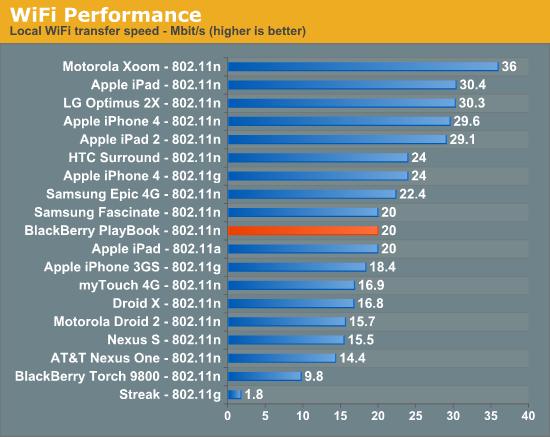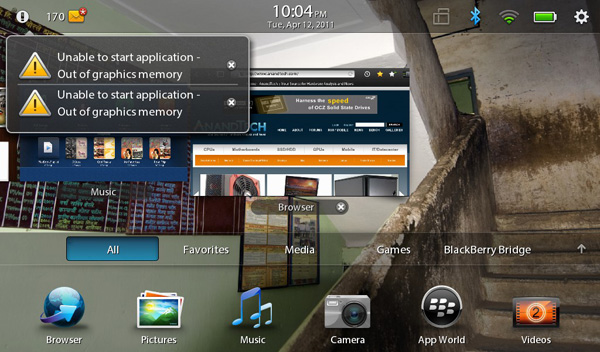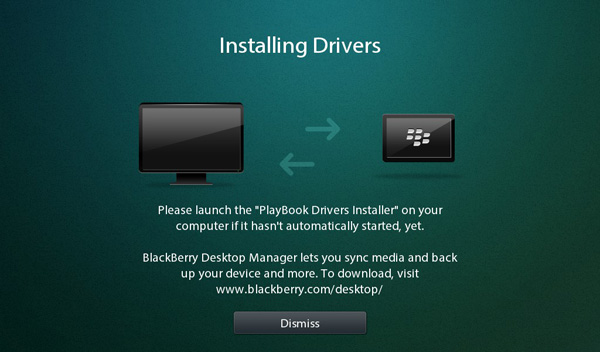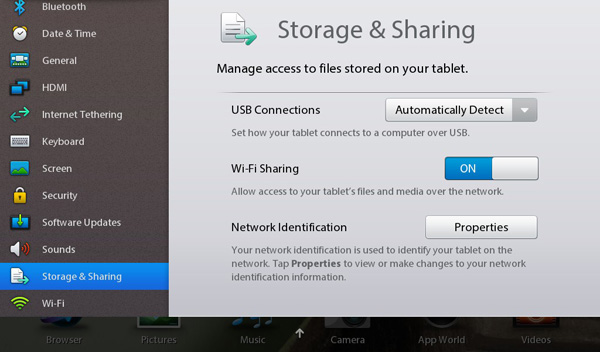The BlackBerry PlayBook Review
by Anand Lal Shimpi on April 13, 2011 9:00 PM EST- Posted in
- Tablets
- Smartphones
- RIM
- BlackBerry
- PlayBook
- Mobile
Memory Limits
Despite the PlayBook having a 1GB of LP-DDR2 memory on-board, this thing can run out of memory quickly - particularly when multitasking with BlackBerry Bridge apps. If you've got a web page loaded in the Bridge Browser, you'll only be able to open a maximum of three other Bridge apps before you run out of memory. For example, I had AnandTech loaded in the Bridge Browser with Messages, Calendar and Contacts open alongside it. If I tried to open MemoPad or Tasks the apps would quit instantly. It's only after I closed the Bridge Browser that I could launch additional Bridge apps. I don't think we're actually using a full gigabyte of memory, but I do think that I'm bumping into whatever portion of memory is reserved for Bridge apps in the above scenario.
Open up enough non-Bridge apps and you'll quickly run out of graphics memory. If you're lucky, you'll even get a nice error or two from the OS:
The biggest GPU memory hog appears to be the browser, particularly with a full web page loaded. RIM appears to keep the entire web page in memory rather than do the old take a picture of the app and display it as a thumbnail trick. As a result having a loaded web page in the browser, even if it's just in the background, eats into your limited available GPU memory. Just as there's performance tuning that has to be done on the PlayBook, there's also a lot of memory usage tuning that must be done as well.
WiFi Sharing
The big joke about the iPad is that despite being Apple's premier "post PC era" device, you start out using it by plugging it into your PC. Har har. The PlayBook is a bit more advanced.
Out of the box the PlayBook is fully functional with two methods of getting data on/off your device. There's the somewhat traditional way, using a USB cable. RIM ships the PlayBook with both Windows and OS X driver support by default. Connect it via USB to your Mac or PC and it'll appear as a removable storage device. RIM was clever enough to have the initial partition that's mounted autorun an executable, prompting you to install the BlackBerry Device Manager.
Once installed, the PlayBook will appear as a shared drive on your computer. You can copy to/from it the same way you would any other network share. The PlayBook exposes three shares that you can access: certs, print and media. Media is where pretty much everything is stored - documents, downloads, photos, videos, everything. You can copy files to/from this share without issue, and it works from both a PC or a Mac.
If you want an even more traditional sync experience, there's also the BlackBerry Desktop Software - also available for PCs and Macs. Unfortunately the current version of the BlackBerry Desktop Software doesn't support the PlayBook so I couldn't thoroughly test it.
You may wonder why the PlayBook appears as a network share rather than a traditionally mounted USB device. For starters, it lets you get around Apple's whole eject-to-remove silliness. Pull a USB mass storage device without first ejecting it under OS X and you'll get a stern warning about potential data loss from your Mac. Network shares don't suffer the same fate. Unplug the PlayBook whenever you want and your Mac won't complain.
The bigger reason for RIM going the network share route is because the PlayBook supports access to its shared volumes over WiFi as well as USB. Flip a switch in the Sharing settings page, supply an optional password and you've got the same full access to the PlayBook's NAND.
The PlayBook doesn't even have to be awake for WiFi sharing to work, it implements some form of wake on LAN. With the PlayBook in standby, hit it over the network and after a short wakeup period (~5 seconds) you'll have full access to the device. The only requirement is that your PlayBook is connected to the same network as whatever device you're trying to access it from.
When it works, WiFi sharing is great. I only have two complaints: speed over WiFi is atrocious and I can't always get WiFi sharing to work, although the latest update seemed to reduce the number of issues I've had.
Pretty much no smartphone or tablet we've tested is particularly speedy over WiFi. Even the Motorola Xoom, at the top of our performance chart, manages a meager 36Mbps. Part of this has to do with the fact that all of these devices are power rather than performance optimized and part of it has to do with NAND performance limitations. The PlayBook is even more disappointing in this regard:

The fastest I could ever write to the PlayBook over 802.11n (~5 feet away from the access point) was at 20Mbps. Typical speeds were closer to 16Mbps however. RIM tells me that there's still a lot of performance tuning that has to be done within the OS and WiFi stack. It expects the PlayBook's WiFi performance to improve, however today it is a known issue. Poor WiFi performance is more frustrating on the PlayBook because of how useful WiFi sharing is.
The PlayBook is pretty hands off when it comes to letting you use the device while you're copying data to it. I tried copying a folder full of photos over to the PlayBook while browsing the same folder on the device, unfortunately in one instance this did cause the photos app to crash. On the bright side, the crash was pretty graceful - there was no error, just an app exit. Relaunching the app worked perfectly afterwards.
I have run into situations where I simply couldn't connect to the PlayBook over WiFi. If the connection failed after two attempts, I usually had to toggle WiFi sharing on/off on the device before it'd start working. With the latest software update I received just over 24 hours ago I've run into this problem a lot less frequently. We'll see if it continues to behave well.
I am impressed with RIM's cross platform support (at least from a Mac/Windows perspective) as well as its embracing of WiFi sharing. I personally would rather just copy data over to my tablet like I would any other computer, having to go through a separate sync app should be optional.













77 Comments
View All Comments
Azethoth - Thursday, April 14, 2011 - link
That is a curious statement. What do you want lots of memory for?I can see memory being better for a phone that you listen to music from as more memory = more of your (compressed) library can fit on it. Personally I only sync particular playlists to my phone / iPad anyway.
As for other stuff, well apps just do not consume a large amount of space. For my iPad 2 I went with the smallest memory size. The larger size I have on my original, er I mean on my sister's "new" iPad, was just a waste for me.
Chloiber - Thursday, April 14, 2011 - link
Because it's an easy way to share things and upgrade your memory if you need more. I won't pay 100$ for 16GB of NAND flash (which cost's like 15$).jjj - Thursday, April 14, 2011 - link
For a device that can shoot and play 1080p video 16GB-64GB of storage is very little (and anything above 16GB is way too costly) Then there are also photos,music,apps that maybe soon will be actually able to do things and become bigger,it is after all a computing device and even if smartphones/tablets are in their infancy we can still hope that they mature sooner rather than later.BuffyzDead - Thursday, April 14, 2011 - link
"The screen is too small to comfortably read in portrait mode and even in landscape things can get a bit cramped." Steve Jobs already warned the entire industry on this point. It's too small to be a successful tablet. Everyone has portability in their Smartphone."Apple's A5 still has a much faster GPU" .and the playbook isn't even shipping yet
"App launches are unfortunately a bit high latency. .....whole process takes a couple of seconds but it feels longer than firing up similar iOS or Honeycomb apps." just throw more CPU at the problem. You know, down the road.
"With no email or calendar apps, the PlayBook doesn't have a whole lot to notify you of. Presently the only notifications the PlayBook will deliver have to do with remaining battery capacity." LOL at this one.
I predict Now, this thing will never sell in volume. Even improved versions down the road won't sell.
3 reasons:
1) It's too small.
2) The User Experience does not even come close to that of the iPad1
3) NO APPS
Yes, while there are company's that may force this down their employees throat, that is not where the growth of tablet use is coming from, in enterprise.
It's coming 100% from employees wanting to use their iPad's in the work environment.
You finish with:
"there are still more revolutions that will take place between now and when the mobile market finally matures"
Ask yourself, Honestly, is there ANYTHING about this "experiment for RIM"
that has an inkling of REVOLUTION ????
Azethoth - Thursday, April 14, 2011 - link
The proper quote is:"While Apple and Google are clearly out to a substantial lead, there are still more revolutions that will take place between now and when the mobile market finally matures. I'm not saying that Apple or Google won't end up on top, I'm just saying that it's not guaranteed they will either."
and
"The PlayBook is a reasonable experiment for RIM, but I need to see more to really recommend the tablet."
See how in context Anand makes sense? Rather than claiming the ridiculous: "this RIM tablet is a revolution", Anand is merely saying that this is an immature industry. Everyone fully expects actual game changing revolutions in this area in the future.
Search this site for Anand's excellent follow up to the iPad 2 release that asks: "How do I as a blogger use a tablet to create [text] content". There were some responses about maybe covers that double as keyboards. There was wishful thinking about voice input maturing real soon now. Mostly there is a need for some kind of interface revolution before a tablet can become a reasonable answer for a blogger on the go. These are the revolutions Anand needs in a tablet.
BuffyzDead - Thursday, April 14, 2011 - link
Correct !I wholeheartedly agree with Anand's review and conclusion:
There are no guarantee's what the future may hold and he can not recommend this Playbook.
1) I wanted to add that this Playbook will in fact be a total failure. Time will prove me right or wrong. Again, I predict Total Failure.
2) I wanted to point out how RIM, as is evident by this Playbook version 1,
has demonstrated Zero in it's capability to provide ANY REVOLUTION.
At most, it's an outright attempt to copy or emulate (poorly) what the iPad REVOLUTION IS.
BTW,
If you think that "designing a tablet" to cater to "the blogger on the go" is a measure of success, then I pray for RIM's sake, you are not on their design team.
Anand has repeatedly pointed out how a tablet might just not be for him, in general.
I have maintained for the past 15 months that the iPad's true REVOLUTION, is that it CREATED a NEW MARKET.
ALL of Apples competitors are playing catchup & copycat to cater to that NEW MARKET, which the iPad CREATED.
SandmanWN - Thursday, April 14, 2011 - link
For real... lay off the coffee and Jobs shlong.melgross - Thursday, April 14, 2011 - link
For real, it's the only tablet so far that sold more than a small number. As many others have pointed out, so far the tablet market is really the iPad market. Other manufacturers have to prove that they can sell a large number of devices. We know that the Tab, is not a real tablet by Google's standards, and that it sold in much smaller numbers than the number shipped to retailers and cell companies. The Xoom is assumed to have managed about 100,000 sales, and what else has there been that seriously competes?Now, the Playbook, which has been criticized by those in the industry for having poor battery life, and problems with the software before release, despite RIM,s denials, is proving, from all the reviews I've now read today, to be having all of those problems just days before release. Pogue has stated that RIM is feverishly sending out updated on a daily basis. That's not good.
Other tablets won't arrive for at least a couple more months.
So what does the market really consist of now?
melgross - Thursday, April 14, 2011 - link
It's hard to say. There are a lot of writers who have said that they type just fine on the iPad's virtual keyboard. Everyone's different. I remember a lot of people complaining about the first iPhone's keyboard, but since then, many, if not most new smartphones have no physical keyboards anymore, so people are getting used to them.I'm typing on my iPad2 now. The only complaints about the way Apple set it up are that I think that too much space is wasted on the two large numeric keyboard call up keys at the bottom of the keyboard, much of which could have been used for other functions, such as an "@" key, for instance. Otherwise, it's fine. On a 7" screen, typing for longer periods will be more problematical.
yelped - Thursday, April 14, 2011 - link
Stop trolling, and PLEASE grow up.Thanks.